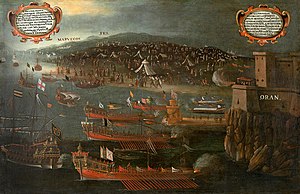Sieges of Oran and Mers El Kébir
| Sieges of Oran and Mers El Kébir | |||||||
|---|---|---|---|---|---|---|---|
| Part of the Ottoman-Habsburg wars | |||||||
 Oran's harbour. Painting of 1613 by Vicente Mestre. | |||||||
| |||||||
| Belligerents | |||||||
|
|
France | ||||||
| Commanders and leaders | |||||||
|
Martín de Córdoba Francisco de Mendoza y Vargas |
Hasan Pasha Jafar Catania | ||||||
| Strength | |||||||
|
1,500 men 90 guns[2] |
100,000 men 30 | ||||||
| Casualties and losses | |||||||
| Unknown |
Heavy human losses, 5 galliots captured, 4 carracks captured[5] | ||||||
Between April and June 1563 the
Background
With the defeat of the
In 1562,
Hassan Pasha, instructed by the Sultan
Siege
Forts San Miguel and Todos los Santos

The siege began on April 3, 1563, when Ottoman troops massively attacked the tower of Todos los Santos, defended by 200 Spanish soldiers.[9] The fierce resistance of the fort's garrison, along with artillery support from Mers El Kébir, inflicted heavy casualties on the attackers.[9] However, once the Ottoman cannons tore down the walls, the fort was soon taken.[9] Meantime Jafar's galleys blocked Mers El Kébir to prevent the city to be relieved from Oran. Ottoman's main objective was to capture Mers El Kébir, as Hassan was warned by several renegades that the Spanish planned to abandon Oran to concentrate on the defense of the other town.[3] Therefore, he destined most of his troops to take the fort of San Miguel, a key point of the Spanish defense, while only a few troops remained blocking Oran.[3]
San Miguel's fort was attacked over 22 days by 24,000 infantry and 400 cavalry soldiers.[9] His few defenders rejected Hassan's offer of surrender and successfully repelled six assaults which left the moat full of dead Janissaries.[10] Among the Ottoman casualties was the governor of Constantine, whose body could be recovered by his men with the permission of Martín de Córdoba.[10] However, despite the stubbornness of the defense, the reinforcements sent from Mers el Kébir were not enough to continue fighting, and on May 8, under cover of darkness, the Spanish survivors retreated to the town.[9]
Siege of Mers El Kébir
Once inside the fort, the Ottoman troops surrounded the city, digging trenches around and placing artillery to break down the walls. On a nearby hill were also installed several culverins to bombard the inner town.[9] Martín de Córdoba, who had less than 500 men available to defend the city, prepared for the assault.[9] This one took place on 20 May. Hassan sent ahead 12,000 Arabs to break the resistance of the Spanish harquebusiers and facilitate the assault by two columns of regular troops which would attack secondly.[11] Despite the heavy losses they suffered, the Arabs managed to scale the walls and raise the Ottoman flag on the battlements. However, the Spanish soon expelled them.[11] In that attack nearly 2,500 men died, mostly falling into the moat around the town.[12]
In the following days, more assaults took place which also failed with great loss of life, although the Spanish situation had become desperate.
Aftermath
After disembarking reinforcements and supplies at Oran and Mers El Kébir, Francisco de Mendoza's fleet returned to Spain.
Notes
- ^ Edwards/Lynch p.570
- ^ San Miguel p.363
- ^ a b c d e f Sánchez Doncel p.180
- ^ Fernández Duro p.49
- ^ a b c Fernández Duro p.53
- ^ Sánchez Doncel p.224
- ^ Braudel p.940
- ^ a b c Sánchez Doncel p.179
- ^ a b c d e f g h i j k Fernández Duro p.50
- ^ a b San Miguel p.364
- ^ a b Fernández Duro p.51
- ^ San Miguel p.365
- ^ Fernández Duro p.52
- ^ a b San Miguel p.370
- ^ a b c d Sánchez Doncel p.182
References
- Fernández Duro, Cesáreo (1895). Armada Española desde la unión de los reinos de Castilla y Aragón (in Spanish). Vol. II. Madrid, Spain: Est. tipográfico "Sucesores de Rivadeneyra".
- San Miguel (duque de), Evaristo (1991). Historia de Felipe II, rey de España (in Spanish). Vol. 2. Barcelona, Spain: Salvador Manero.
- Sánchez Doncel, Gregorio (1991). Presencia de España en Orán (1509-1792) (in Spanish). Toledo, Spain: I.T. San Ildefonso. ISBN 978-84-600-7614-8.
- Edwards, John; Lynch, John (2005). Edad Moderna: Auge del Imperio, 1474-1598 (in Spanish). Madrid, Spain: Editorial Critica. ISBN 978-84-8432-624-3.
- Braudel, Fernand (1995). The Mediterranean and the Mediterranean world in the age of Philip II. Vol. 2. Los Angeles, USA: University of California Press. ISBN 978-0-520-20330-3.
